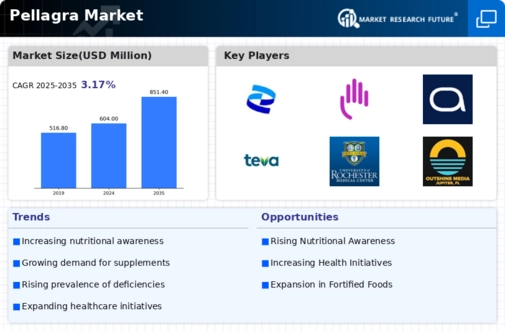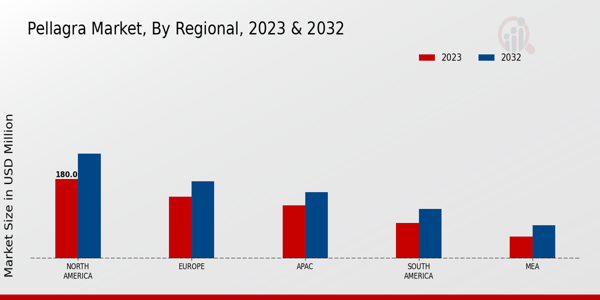Rising Nutritional Awareness
The Global Pellagra Market Industry is experiencing growth driven by increasing awareness of nutritional deficiencies. As populations become more informed about the importance of vitamins and minerals, the demand for niacin-rich foods and supplements is likely to rise. This trend is particularly evident in developing regions where pellagra remains a concern. For instance, educational campaigns about the health impacts of niacin deficiency have been implemented in several countries, leading to a projected market value of 604.0 USD Million in 2024. Such initiatives not only aim to reduce the incidence of pellagra but also enhance overall public health.
Market Trends and Projections
Expansion of Supplement Market
The Global Pellagra Market Industry is also benefiting from the expansion of the dietary supplement market. As consumers increasingly seek preventive health solutions, niacin supplements are gaining popularity. This trend is particularly pronounced in regions where dietary intake of niacin is insufficient. The supplement market is projected to grow at a CAGR of 3.17% from 2025 to 2035, reflecting a growing recognition of the importance of micronutrients in maintaining health. Companies are responding by developing innovative niacin formulations, which could further enhance market growth and accessibility.
Emerging Research and Development
Ongoing research and development efforts are shaping the Global Pellagra Market Industry. Scientists are exploring new ways to enhance niacin bioavailability and efficacy in preventing pellagra. Innovations in food technology, such as the development of fortified foods and functional foods, are gaining traction. These advancements may lead to improved dietary solutions for populations at risk of deficiency. As research continues to evolve, it is anticipated that the market will adapt, potentially reaching a valuation of 851.4 USD Million by 2035. Such developments could play a pivotal role in addressing the challenges associated with pellagra.
Government Initiatives and Support
Government interventions play a crucial role in the Global Pellagra Market Industry. Various health departments are actively promoting programs aimed at eradicating nutritional deficiencies, including pellagra. These initiatives often include fortification of staple foods with niacin and public health campaigns to educate communities about dietary needs. For example, in several countries, governments have allocated funding to improve food security and nutritional education, which is expected to contribute to a market valuation of 604.0 USD Million in 2024. Such support is essential for reducing the prevalence of pellagra and improving health outcomes.
Increased Incidence of Pellagra in Vulnerable Populations
The Global Pellagra Market Industry is influenced by the rising incidence of pellagra, particularly among vulnerable populations such as those in low-income regions. Factors such as poverty, food insecurity, and lack of access to diverse diets contribute to niacin deficiency. Reports indicate that certain areas are witnessing a resurgence of pellagra cases, prompting health authorities to take action. This growing concern is likely to drive market growth, with projections indicating a market size of 851.4 USD Million by 2035. Addressing this issue is critical for improving health and nutrition in affected communities.












